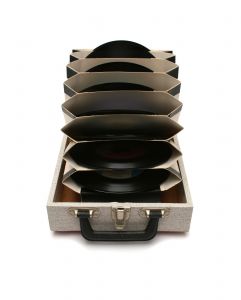 If there was any doubt before this year that music sales were headed downward, it is now certain. At the same time, streaming and mobile listening are up.
If there was any doubt before this year that music sales were headed downward, it is now certain. At the same time, streaming and mobile listening are up.
These disruptive trends signal major changes to how people layer music into their lives:
- The radio/CD duopoly has been dismantled.
- Home stereos and mobile boomboxes seem antique.
- The workplace has become a third listening outpost added to the home and the car.
- Music has been untethered from locations, and is now attached to the person (via smartphones, wearables, and headphones).
- Music as a collectible is moving from stores to the cloud — an apt metaphor for music which seems as accessible as air.
Listening to music and acquiring music are entwined. That symbiosis persists regardless of changes in listening formats and music products. When people hear music by chance, they want to acquire it, to listen whenever they want. In 2014, collecting music has a new meaning, and increasingly occurs without the need of a traditional music product — physical or virtual. Like cable TV, access is the product.
Research shows that radio’s historic role of promoting music awareness and discovery remains important to many people. But as sales go down, radio’s role in building a music collection is less direct.
 With Internet radio like Pandora, the connection to music acquisition can be more direct than with AM/FM, via “Buy on iTunes” links. But as download sales go out of favor, Pandora’s role in acquiring a personal music collection is reduced. (Same for iTunes Radio, despite its built-in connection to iTunes downloads.)
With Internet radio like Pandora, the connection to music acquisition can be more direct than with AM/FM, via “Buy on iTunes” links. But as download sales go out of favor, Pandora’s role in acquiring a personal music collection is reduced. (Same for iTunes Radio, despite its built-in connection to iTunes downloads.)
On-demand platforms like Spotify provide the same type of passive listening, slanted to the listener’s taste. At the same time, these services give subscribers music-collection privileges, mobile style — downloading songs to a phone for liberated listening in all environments. It’s not free, but it feels free, and costs about as much as 10-12 CD purchases a year, or 90-120 single tracks.
That is the crux of the consumer equation: access to everything for the cost of owning a few things. In the early days of music subscriptions (Rhapsody being the godfather), “music rental” developed a negative stigma, and its impermanence was assigned a negative value. It’s still true that if you end the subscription, you lose your collection. So it’s not really a music collection as people collected in the 2oth century.
But in a world where music not only feels free, but increasingly is free (YouTube being the grand tectonic example), acquiring music is more about organizing the oceanic melodic stream washing over technology-adept consumers.
 One growing catalyst of this trend is the music-identification app, a category dominated by Shazam and SoundHound. These apps, which identify music wherever in the world it is heard, bring the “celestial jukebox” down to earth where it is even more vast and connected to the user.
One growing catalyst of this trend is the music-identification app, a category dominated by Shazam and SoundHound. These apps, which identify music wherever in the world it is heard, bring the “celestial jukebox” down to earth where it is even more vast and connected to the user.
Increasingly, these apps function as pivot points between what you hear and how you acquire. They enable purchasing an identified song in iTunes, for those who still favor outright ownership. But more ominously for music-download merchants, Shazam and SoundHound can fling your song discoveries into some of the most popular on-demand services.
For paying subscribers to one of those services, this becomes an acquisition method so easy and instant, it could have been written into a futuristic sci-fi scenario 20 years ago. Hear something on radio, TV, or in a restaurant, touch a piece of glass you carry in your pocket, and wham — you “own” that song and can listen to it whenever and wherever. It is acquired to your personal ecosystem.
Apple reportedly recognizes the power of music-ID apps, and how savvy music-lovers build their life soundtracks. Apple is planning to build the ID function (provided by Shazam technology) into the next version of iOS, its iPhone software. Connected to Siri, the voice-activated virtual assistant, such a system could further tighten the connection between listening and acquiring — in whatever ways Apple attempts to funnel its users. If Apple adds an on-demand music service (as rumored), a user could murmur a few words into the phone, and seconds later own a song as a file, an iTunes Radio station, or a subscription download.
Music collecting has never been so easy, so cheap, or so different.
